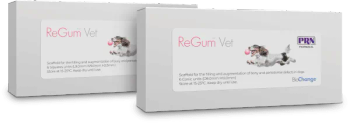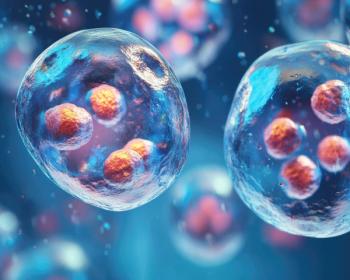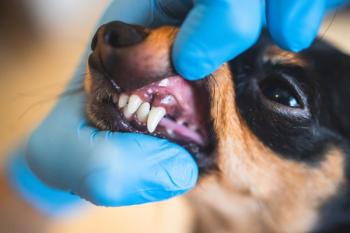
Unusual dental presentations, a case review (Proceedings)
Diamond is a 12-year-old female spayed Dalmatian that was presented for swelling under the left eye for a two-week duration.
Case # 1
Case summery
“Diamond” is a 12-year-old female spayed Dalmatian that was presented for swelling under the left eye for a two-week duration. The RDVM thought there was involvement of the upper 4th pre-molar and possible the first molar. The patient was placed on Baytril but then was switched to clavamox after they were referred to the Dentistry service for dental radiographs and treatment. The patient is also on synovi chews and previcox for osteoarthritis and proin for urinary incontinence.
Diamond's physical exam was with in normal limits and her awake oral exam revealed moderate dental tarter on all her teeth and a small red nodular tissue was present above the left 4th pre-molar.
Diagnostics:
Diagnosis:
Treatment:
Case #2
Case summery
Banjo is a 5 year old male intact German Shepherd Dog who presented to the small animal dentistry service for a 3 month history of non-healing tooth extraction sites. Banjo was originally seen by his RDVM in October for suspected bilateral carnasial tooth abscesses. At that time both of Banjo's maxillary carnasial teeth were extracted and the sockets were packed with blood-stop hemostatic gauze. Banjo presented a month later to his RDVM for swelling in the area of the extractions. Banjo was anesthetized and both sockets were found to contain purulent material, hair, and other debris. Both sockets were flushed and oral clindamycin was also prescribed. The swelling reoccurred once the antibiotics were finished and Banjo was anesthetized by his RDVM whom flushed the pockets, applied Doxirobe and Consil putty to both sockets. Oral clindamycin was again prescribed.
Current history:
About one year prior to his dental problems Banjo had an incident where a bone had become wedged between the upper carnassial teeth and the teeth had to be removed by his RDVM. Banjo has had no previous medical illnesses or surgeries. Banjo is up to date on vaccinations and currently receives a monthly flea and tick prevention.
Physical exam findings:
T- 101.8 P - 96 R - pant MM - pink CRT - <2s BCS - 5/9 EENT - 3cm swelling under left eye. Unable to palpate the swelling due to pain. Unable to adequately assess oral cavity due to patient resistance. Eyes clear and bright OU. Ears clean and free of debris AU PLN - no peripheral lymphomegaly present on palpation CVR - no murmurs ausclutated. Pulses strong and synchronous. Lung sounds clear bilaterally ABD - non-painful, no masses or organomegaly on palpation. Derm - no gross abnormalities Neuro - no abnormal findings MS - no abnormal findings UG - no gross abnormalities. Intact. PAIN SCORE: 1-2 CURRENT WEIGHT: 38kg
Diagnostics:
Diagnsis:
Treatment:
Case #3
Case summary:
Routine Dental Cleaning Current History: Macy is a 9yr old female spayed mixed breed who presented to the Dentistry Service on 11/18/09 for a routine dental cleaning. Macy has never had a dental cleaning before and presents today with moderate dental calculus, discoloration of her lower left canine and mild halitosis. Macy is an indoor dog who is let out into a fenced in yard. Six months out of the year she lives with another dog. Her diet consists of Science Diet Senior dry 1.5 cups BID. She is not receiving any medication or supplements. She is up to date on her vaccinations (wellness visit 5/09 - did CBC/Chem/HW), she occasionally receives Frontline and Heartguard. Macy was adopted as a rescue when she was 8 months old and has no prior medical history. Physical Examination Findings: T 101.4F P 120bpm R pant MM pink CRT <2sec Wt: 28.5kg Hydration: adequate Attitude: BAR BCS: 7/9 EENTO: OU clear with lenticular sclerosis, AU clear of debris, no nasal discharge, throat palpation within normal limits, moderate dental calculus and mild halitosis PLN:left popliteal lymph node moderately enlarged CVR: strong synchronous pulses, no arrhythmias or murmurs, lung fields clear bilaterally MSI: ambulatory x4, well muscled bilaterally, hair coat smooth, no lameness noted; 3x4cm area of traumatic alopecia on dorsoproximal tail UG/GI: tense non-painful abdomen, no organomegaly or masses palpated, no masses palpated in mammary chains.
Diagnostics:
Diagnosis:
Treatment:
Case #4
Case summary
Presenting Complaint: Fractured Right Maxillary Canine Tooth
Current history:
Albert is a 5 year old male castrated grizzly bear that presents to the NCSU VTH Dentistry Service for evaluation and treatment of a fractured canine tooth. The fracture occured last Saturday (1/15/11) while Albert was being transported in a horse trailer to be weighed. Albert was reportedly holding onto the bars of the trailer when he lost his balance. The owner did report there was a small amount of blood originating from the pulp canal after the incident and when he applied pressure, Albert objected. Since the incident, the pain seems to have dampened. The owner's do not report that Albert has had any difficulty eating/dropping food. The owner also report that Albert suckles on the bars of his cage frequently and always has and in doing so has worn down the occlusal and labial surfaces of his incisors. Currently Albert receives Biofuel, BioAlert, B6, Glucosamine with MSM, and 1300 mg of Aspirin BID. Albert was dewormed for tapeworms with Droncit about a month and a half ago. Albert is fed an Omnivore chow, fruits and vegetables, and one can of salmon every day, but his appetite is reported to be down as it always over Winter. Albert has been here twice before in 2007 and 2008 for evaluation of hindlimb lameness and to be neutered. His hindlimb lameness has not resolved and our Orthopedic Service will evaluate him today. Physical Examination Findings: T: 98.1 F P: 55bpm R: 12 bpm MM: pink CRT: <2sec W: 380 lbs. EENT: Eyes clear and visual, no discharge OU; Moderate black/brown discharge AU; Small angled fracture of tip of 104 with pulp canal exposure, mild to moderate enamel wear on lingual and palatal surfaces of 304, 404, 204, and 104 respectively, moderated enamel/dentin wear of occlusal and labial surfaces of 103-203 and 403-303, very mild calculus accumulation. PLN: all palpate small and symmetric CV/R: Normal sinus rhythm and bronchovesicular sounds ausculted bilaterally MS/I: BCS: 5/9; nice hair coat, 3, 1-2cm areas of scabbing on ventral neck that a small amount of purulent material could be expressed from; Well-muscled Neuro: Full neuro exam could not be performed, but no deficits noted while bear was awake Pain Score: 0/4
Diagnostics:
Diagnosis:
Treatment:
Case #5
Case summary
Presenting Complaint: Persistent nasal discharge and halitosis Current History: Jay is a 4 year old, male castrated, domestic shorthair cat who presented to the NCSU Dentistry Service for recheck of previously fractured mandible and maxillofacial bones from a hit-by-car accident. Overall, Jay appears to be doing well at home. He is eating well and has no episodes of vomiting, diarrhea or coughing. He persistently has a nasal discharge that is mucopurulent at times. He continues to have sneezing episodes at home where he will sneeze multiple times and produce mucous. This mucous is sometimes bloody. Last night, Jay had a very long episode of sneezing and produced many areas of bloody mucous on the bed and on the wall. Jay has also changed his drinking habits within that last week. He no longer laps water from the bowl, but will put his paw in the water bowl and lick water from his paw/face. Jay's owners have also noticed increasingly foul halitosis when Jay opens his mouth and sneezes. Back in October, 2011, Jay was treated at the NCSU Dentistry Service for a comminuted fracture of his mandible and fractured hard palate, as well as dental fractures. He was treated with an esophageal tube and external fixators. He has had multiple procedures where teeth have been extracted to help facilitate his healing process. Currently, Jay's upper left premolar is causing irritation and ulceration of his mandibular gingiva. Physical Examination Findings: EENT: Mild epiphora OS. Clear OD. Serous nasal discharge from left nostril. Majority of left whiskers are broken off, and one right whisker is broken. Licking of the left paw, and washing of left face/whiskers was noted in the room. Face appears symmetrical. Throat palpates normally. MSI: Good hair coat; no evidence of ectoparasites. symmetrical muscling. Medial side of left forepaw is wet with mild erythema. Jay was actively licking in the room as he was grooming the left side of his face/nose. PLNs: No lymphadenopathy noted. Neuro: Ambulatory x 4. CN's intact. Full neurological examination not performed. GI/GU: Non-painful upon abdominal palpation. No organomegaly or masses noted. CV/R: No murmur or arrythmia noted. Lungs clear, bilaterally. Dental: Area of erythema and gingivitis on left mandibular area where maxillary P4 is coming in contact with it. Severe halitosis noted in room. Pain Score: 0/4 Current Weight: 6.38 kg .
Diagnostics:
Diagnosis:
Treatment:
Newsletter
From exam room tips to practice management insights, get trusted veterinary news delivered straight to your inbox—subscribe to dvm360.






